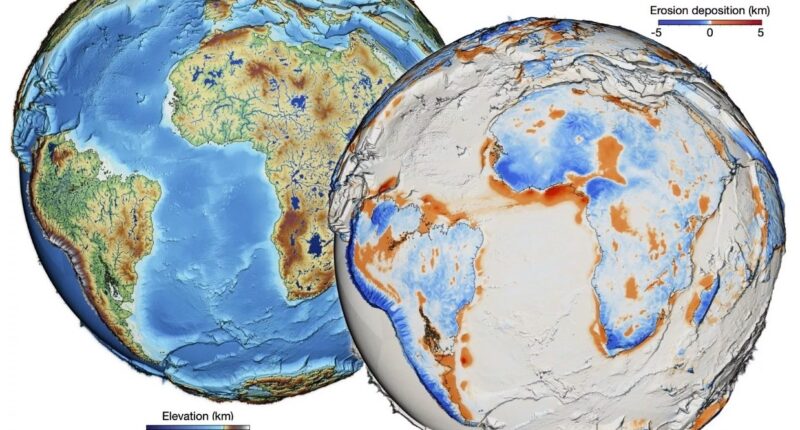AN awe-inspiring new timelapse has revealed how scientists believe continents shifted over the past 100million years in “unprecedented” detail.
The animation of the Earth’s surface shows tectonic plates rolling across the planet to create volcanos, ocean basins, and mountains.
Scientists have been studying the Earth’s topography for generations.
All current knowledge of tectonic plates, erosion, and precipitation, was applied to a state-of-the-art model released by the University of Sydney.
The viewer can watch millions of years go by in seconds as a massive plot of land transforms into what we now know as the seven continents.
Huge chunks of the Earth’s crust can be seen diving under each other to create volcanos and earthquakes.
Precipitation essential to transforming the world over the years is also highlighted in the model.
The rain and snow alter carbon dioxide levels in the air which creates a feedback loop between the land and the atmosphere.
“While the dance of the continents has been studied extensively, we are still limited in our understanding and representation of how the Earth’s surface has evolved,” Tristan Salles, a senior lecturer in geosciences at the University of Sydney who wrote about the model, told Live Science.
“What we bring with this new model is a way to evaluate how this surface has changed (globally and over geological time scales) shaped by its interactions with the atmosphere, the hydrosphere, the tectonic and mantle dynamics.”
Most read in News Tech
The model starts around 100million years ago.
Pangea, which was believed to be a combination of the continents now known as North America, Africa, South America, and Europe, started drifting apart 200million years ago.
The viewer can tell there is a slight distance between the pieces of land when the model begins.
The blue areas represent the flow of water while the red areas highlight sediment deposited by erosion.
“This unprecedented high-resolution model of Earth’s recent past will equip geoscientists with a more complete and dynamic understanding of the Earth’s surface,” said geologist at the Institute of Earth Sciences Laurent Husson in a statement.
By showcasing aspects such as tectonic movement, the flow of the ocean, and erosion, scientists are able to get a more holistic view of how the Earth became what it is today.
Researchers found that sediment moved in much greater volumes than experts previously thought.
For example, sediment could have rushed out into the ocean between about 60million and 30million years ago due to the rise of the Himalayan Mountains and the Tibetan Plateau.
According to Salles, this is significant as some of the earliest forms of life were thought to have been formed in shallow pools of water with sediment.


“It is thought that sedimentation flux may have provided a source of nutrients to these early organisms, allowing them to thrive and evolve over time,” Salles said.
“We envision that our model could be used to test such long-standing hypotheses regarding the origin of life on Earth.”










